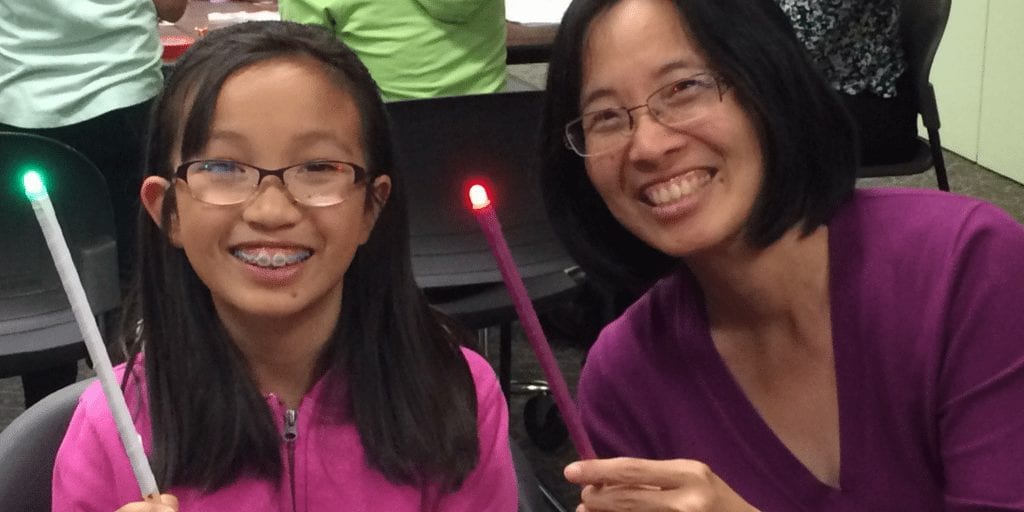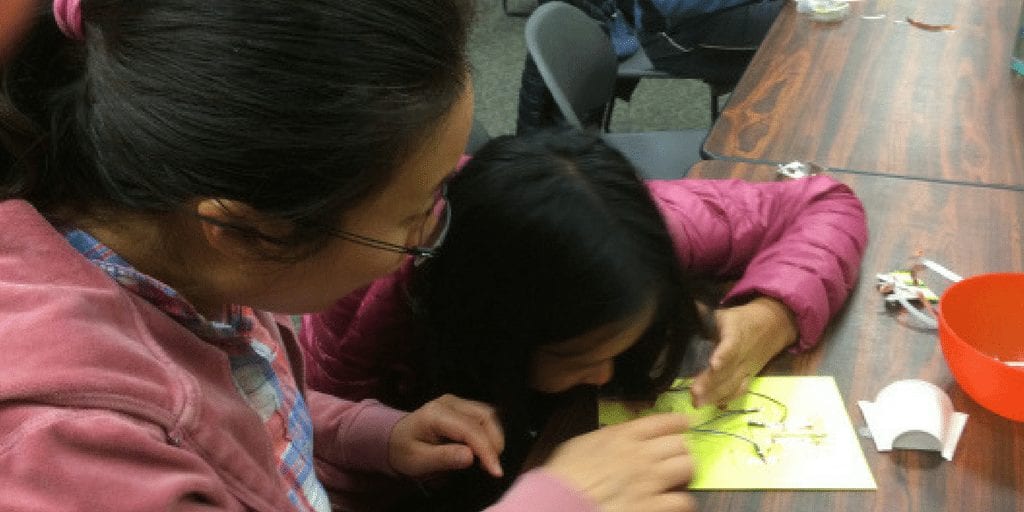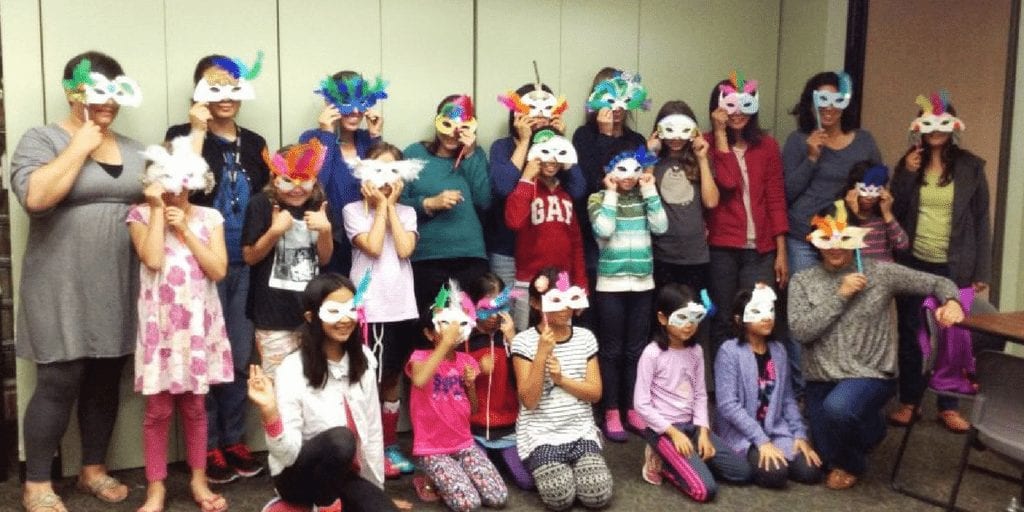Public libraries have a unique opportunity to expand the reach of STEM. “Public libraries provide a ‘third space’ beyond the formal classroom and home that can unite schools and communities around STEM education and complete the community’s STEM learning ecosystem.”1 What’s more, public libraries are accessible and trusted spaces in the community; these elements help to increase access for youth and parents who are underserved and underrepresented in STEM. In celebration of National Library Week April 8-14, we showcase one library that expanded its mission with a new program to support families and help close the opportunity gap in STEM.
First Tuesdays are a special time at the Sunnyvale Public Library. Girls ages 8-12 line up with their mothers (or other significant female) at 6:30 PM for a Making program. Nancy Andrus was inspired to create Make-HER, a Making program with a twist. What we especially like about this program is that it brings together girls and their mothers and encourages them to put down their cell phones and connect with each other over hands-on projects. Projects are as creative and varied as the mentors that Nancy brings in to lead them– light-up Harry Potter wands, wearable technology, and optical illusion toys. The program was launched with funding from the Pacific Library Partnership of Innovation and is currently supported by the Friends of the Sunnyvale Library.

Photo Credit: Make-HER, Sunnyvale Public Library
Bright spots and lessons learned
Me too: Benefits for girls and mothers
“I thought [the program] was for my daughter. It’s liberating for me as I got to do activities.” This sentiment was shared among mothers who participate in Make-HER.
Most family STEM workshops are open to all parents; Make-HER is just for mothers (or significant female figure) and their daughters. In a survey about science education, 36% of mothers reported that they didn’t feel confident enough in their scientific knowledge to help their children engage in hands-on science activities.2 Mothers in Make-HER shared, prior to the workshops, that they typically redirected their daughters’ questions and homework involving math and technology to their husbands. Make-HER is helping change this dynamic. Over time, mothers’ confidence and knowledge increased through these workshops.
Mothers just needed a space to try new skills, to feel comfortable working through challenges, and to see themselves in a new light.

Photo Credit: Make-HER, Sunnyvale Public Library
Girls as young as 6 years old already have beliefs about computing that are gender-stereotyped.3 With these stereotypes, girls express less confidence and interest in tech pursuits like robotics and programming. Programs like Make-HER are working to break the confidence gap. Seeing their mothers becoming more confident and competent, do girls feel different about STEM and their own capabilities? This is a question we hope that research-practice partnerships will explore in STEM programs for girls and their mothers.
Instructors as role models — Andrus recruits women with both technical savvy and a passion for STEM to lead the sessions. These LadyMakers —as they’re called— not only lead tech activities that are both challenging and fun but also serve as role models. With a mini-introduction, the role models share their personal story, what they like about technology, and life outside work. They have diverse interests including fine arts, engineering, technology, and anthropology. Andrus shares, “LadyMakers model the many ways STEM can be used to augment and express personal interests. I hope girls find their personal entry points to STEM. That’s one reason I ask instructors to teach to their passions, rather than my dictating Make-HER content. LadyMakers also appreciate the chance to get creative and try out new ideas.”
The role models did more than lead tech activities; they helped bolster confidence and support growth mindset. For example, Tenaya Hurst, Education Accounts Manager for dog hunter LLC and Arduino.org, celebrated the engineer design process, mistakes and all. As Hurst checked in with the mothers and daughters, she asked, “Who got two lights not to work?” When some admitted that they were having problems, Tenaya celebrated, “Failure, failure!” She playfully removed the stigma of failing and opened a conversation about successes and challenges. For females–who often are held back by lack of confidence, not their lack of ability–this support from Hurst was priceless.
High interest and online registration are nice to have but they compete with equity and access
Clearly interest in STEM is present in Sunnyvale. In fact, parents shared that workshops fill up fast. On my first visit, there were 38 pairs on the waitlist. Many of the families who participate are repeat participants.

Photo Credit: Make-HER, Sunnyvale Public Library
But what if a mother doesn’t have easy access to the Internet? What if her job or family responsibilities doesn’t allow her to register at exactly 9 AM at the start of the work week? What if her navigation and keyboard skills aren’t the best? Who is privileged and who is disadvantaged by this registration system? Should families be able to attend as often as they want, or should registration advantage new families?
Andrus ponders these questions and wonders how to balance competing approaches for Make-HER. Can the library support families who have so much interest that they keep signing up along with families who might have difficulty signing up online or even be reluctant to sign up at first but would have the most to gain? Andrus sees the benefits of deepening interest and skills with repeat engagement in the series as well as bringing in new families. Is there a way to think about these questions so the solution is not either/or? These are questions that Andrus has been grappling with.
To try and support more families, Andrus started an afterschool Maker program at Columbia Middle School. While this program is bringing Making to more girls in a community that is under-resourced, it isn’t a mother-daughter program. Although not quite a perfect solution, it is a successful effort to increase the library’s outreach. Andrus is exploring the possibility of evening mother/daughter workshops for younger elementary age.
Thank you for the feedback: The delicate role of partnering with role models
Navigating the relationship with LadyMakers presents both an opportunity and a challenge. Debriefs can create time and space to share feedback. While we are always appreciative of role models, we also want to improve the quality of our programs. To help balance these dynamics, we can begin by inviting role models to share what they thought went well and what they had challenges with or thought could have been better. What do they wish they had known in advance? What would they recommend to the next group? Discussion around these questions can help address areas for program improvement and help role models learn ideas for their next outreach effort. Andrus shared that she supports her team of LadyMakers with efforts like a group brainstorm dinner and is looking to do more in this area.
***
A “Mover and Shaker.” We agree with the Library Journal’s description of Nancy Andrus. We appreciate Andrus’ vision and effort to create and sustain Make-HER. Even more, we recognize her openness to our observations and desire to learn and grow to make Make-HER an evolving program.
Learn more with these resources
You can read about Andrus’ work at the Sunnyvale Library on the Make-HER website.
The Ideabook. Libraries for Families offers a wealth of ideas beyond random activities for families. Published by the Harvard Family Research Project with the Public Library Association.
Libraries Ready to Code teaches computer science and computational thinking skills. Supported by Google and the American Library Association.
National Library Week is scheduled April 8-14, 2018. This year’s theme is Libraries Lead.
STEM Equity in Informal Learning Settings: The Role of Public Libraries provides research and practices to help increase STEM equity and access for historically underrepresented K‐12 youth.
- Shtivelband, A., Riendeau, L., Wallander-Roberts, A., & and Jakubowski, R. (2016). Implementing Effective STEM Programming in Public Libraries: Eight Recommendations. Report to Space Science Institute’s National Center for Interactive Learning. P. 7. Retrieved from http://www.nc4il.org/images/papers/Research-White-Paper-121216.pdf
- Bayer Facts of Science Education Survey. (2015).
- Cheryan, S., Master, A., & Meltzoff, A. N. The gender gap in tech isn’t set in stone. The Los Angeles Times Op-Ed, Sept. 25, 2017.

